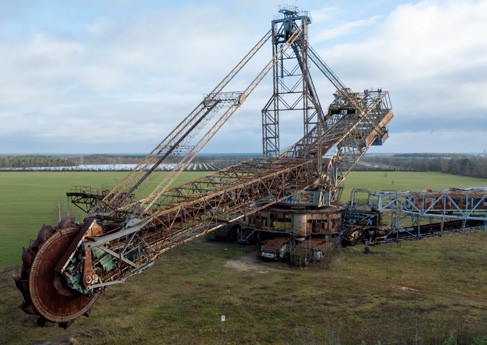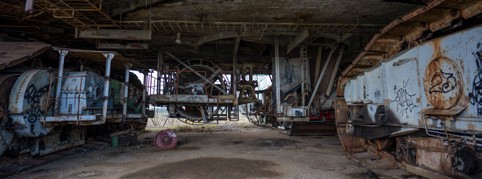If you like your heavy kit big, unique and a bit weather-beaten, Bagger 1473, better known as the Blue Wonder, is hard to beat. Built in the 1960s in what was then East Germany, this SRs 1500-series bucket wheel excavator spent nearly four decades peeling away overburden in the Lausitz lignite fields before clocking off in 2002. It now sits in a field near the EuroSpeedway Lausitz (Lausitzring), a steel skyline of booms and belts you can spot from the road.
The machine is about 50 metres tall and roughly 171.5 metres long.
It ran on grid power, about 5.55 MW at 6 kV, crawled on six tracked units at up to 6 m/min, and fed a near-constant stream of material via a 12.5-metre bucket wheel with ten 1.5 m³ buckets. At full chat, the theoretical output is just over 5,100 m³ per hour. That continuity is the whole point of bucket wheel excavators: they’re conveyor feeders, not truck-shovel sprinters.
“IT MAKES YOU
THINK ABOUT
WHAT IT TAKES
TO MOVE EARTH AT SCALE.”
Now to the bit most people talk about: the state it’s in. The Blue Wonder is striking, but it’s also tired, windows smashed, panels rusting, cables long gone, and graffiti creeping over the paint wherever you look. That vandalism and theft is exactly why local councils once pushed to scrap it on safety and cost grounds. Heritage authorities stepped in back in 2019 and formalised protection, which stopped the cutters, but not the weather, and not the taggers. The result is a legally protected monument that still looks abandoned.
Among the tags, one line gets shared around a lot in urbex clips: “THIS MACHINE EATS FASCISTS.” It’s a cheeky twist on Woody Guthrie’s wartime slogan (“This machine kills fascists”), and it suits the sheer appetite of a bucket wheel that once chewed through benches day after day. Several social posts from recent months call out that line specifically, and it captures the mood on site: half museum piece, half folk art canvas.
Bagger 1473 was a child of the Iron Curtain. It was manufactured in the German Democratic Republic (GDR) by VEB Schwermaschinenbau Lauchhammerwerk, part of the state-owned heavy engineering combine that Westerners usually shorthand as TAKRAF. In other words, it’s a product of a planning system that prized electrified, continuous excavation to keep brown coal moving, and it did exactly that from 1965 until retirement.
How did it end up in a field? When mining wound down at Tagebau Meuro, three municipalities teamed up to save the excavator. In late summer 2003 they walked it about 8.5 km to a public spot near the race circuit as a monument to the region’s mining past. That move alone, keeping public roads open while shepherding a 3,850-tonne machine across industrial tracks, was a feat. But saving something is one thing; paying for decades of upkeep is another.
The pressure points haven’t gone away. In 2019, plans to dismantle the excavator (with the wheel kept as a relic) triggered the monument ruling that still protects it. Even so, the future remains hazy. Local reporting and official notes in 2024–25 describe ongoing arguments about money, safety and whether the excavator should stay on the protected list at all. In short: it’s safe for now, but only as long as someone funds stabilisation.
That’s the limbo the Blue Wonder sits in today.
There’s also the identity confusion worth clearing up. Online, Bagger 1473 is often mislabelled as Bagger 258 another famous “Blue Wonder.” The preserved machine near the Lausitzring is 1473. The mix-up comes from markings on a plate and years of copy-paste errors, but the technical record and local sources are clear on the 1473 ID. If you’re captioning photos, that detail matters.
Why should anyone in the industry still care? Beyond the spectacle, Bagger 1473 is a physical lesson in continuous mining design, electrified power, steady flow to belts, and massive structures built to run predictably for decades. Swap the relay logic for PLCs and sensors and the blueprint isn’t far off what modern operators are chasing under “pit electrification” and energy-per-ton metrics. It’s also a reminder that reputations outlive projects: a community can love a machine enough to save it, but love doesn’t pay for scaffolding, corrosion control or fencing.


From ground level, you’ll see two stories at once. Up close, it’s the GDR’s engineering writ large: latticework booms, guyed towers, planetaries and reducers everywhere you look. Step back, and it’s a giant canvas – rust, sky, and, yes, a line of paint that reads “THIS MACHINE EATS FASCISTS.” Either way, the Blue Wonder still does its job. It makes you think about what it takes to move earth at scale – and what it takes to keep the memory of that work standing once the belts stop.
Specs at a glance: height ~50 m; length ~171.5 m; mass ~3,850 t; power 5.55 MW via 6 kV supply; travel up to 6 m/ min on six crawlers; bucket wheelØ 12.5 m with 10 × 1.5 m³ buckets; theoretical capacity ~5,130 m³/h. Built in the GDR by VEB Schwermaschinenbau Lauchhammerwerk; worked 1965–2002; moved ~8.5 km to its current site in 2003; protected from scrapping since 2019, future funding unresolved.